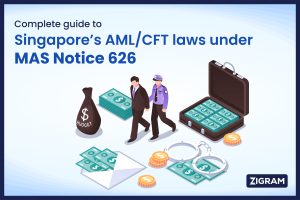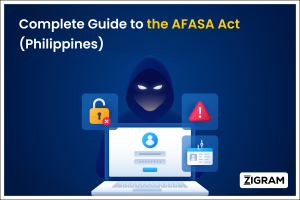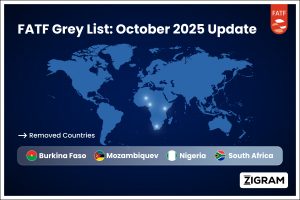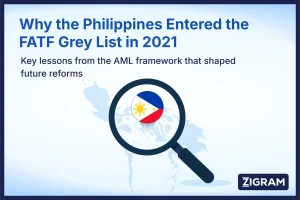As Nepal’s financial sector grows and digitizes, so do the risks of money laundering and terrorist financing. In this evolving environment, Suspicious Transaction Reports (STRs) and Threshold Transaction Reports (TTRs) are not just compliance tools—they are essential to detecting illicit financial activity and safeguarding the economy.
Nepal’s anti–money laundering (AML) regime is anchored in the Asset (Money) Laundering Prevention Act, 2008 (ALPA) and its amendments. The Financial Information Unit (FIU-Nepal), housed within Nepal Rastra Bank, oversees STR and TTR reporting, guided by comprehensive frameworks and sector-specific instructions. As a member of the Asia/Pacific Group (APG) and the Egmont Group of FIUs (since 2015), Nepal is connected to global AML/CFT standards.
This article offers a deep analysis of Nepal’s STR/TTR regime, evaluates its legal and procedural structure, reviews 2023/24 reporting trends, benchmarks practices against FATF standards and global peers, and recommends actionable reforms.
Also, for a broader understanding, read our article on cost-effective AML Solutions for Nepal as a path to exit its current status in the FATF grey list: Cost-Effective AML Solutions for Nepal
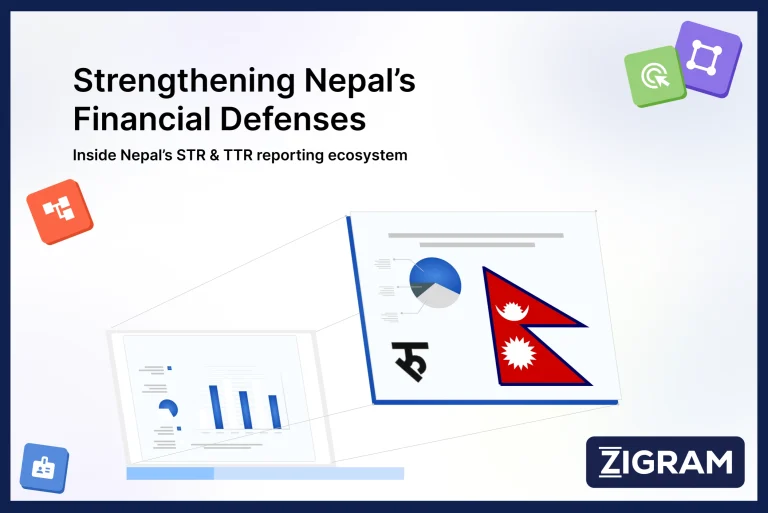
Legal and Regulatory Framework
Suspicious Transaction Reports (STRs):
Reporting entities in Nepal are obligated to file STRs when there are reasonable grounds to suspect that a transaction may be linked to money laundering (ML) or terrorist financing (TF). STRs must be submitted within three working days of the suspicion being identified. These requirements are governed by ALPA and elaborated in FIU-Nepal’s STR Guidelines (2076).
Threshold Transaction Reports (TTRs):
TTRs must be filed for transactions that meet or exceed specified monetary thresholds. ALPA Section 10A mandates reporting within 15 days. FIU-Nepal’s TTR Guidelines (2076) outline different thresholds based on sector-specific risk. These include:
- NPR 1 million for cash deposits/withdrawals in banks
- NPR 1 million for cross-border transfers
- NPR 500,000 for currency exchanges
- NPR 10 million for real estate transactions
- Sector-specific thresholds for insurance, casinos, and precious metals
All reporting entities (REs), including financial institutions and designated non-financial businesses and professions (DNFBPs), are obligated to comply.
International Standards:
Nepal’s STR and TTR frameworks align broadly with FATF Recommendations, particularly Recommendation 20 (suspicious transaction reporting) and Recommendation 10 (customer due diligence). STRs in Nepal must be filed irrespective of transaction value, which is consistent with international norms.
STR System: Analysis and Process
Definition and Scope:
An STR is filed when a transaction raises reasonable suspicion of ML or TF. This includes both completed and attempted transactions, with no monetary threshold required.
Reporting Mechanism:
STRs must be submitted through goAML software for regulated financial institutions. Others may submit signed paper reports, although goAML adoption is expanding. Each report must include a narrative explaining the basis for suspicion, supported by documents such as KYC, account statements, and any media references.
Challenges:
Despite comprehensive guidelines, the number of STRs filed by non-bank entities remains low, indicating underreporting. Additionally, the quality of narratives and documentation varies, reducing the analytical value of STRs.
TTR System: Structure and Compliance
Definition and Reporting Requirements:
TTRs are mandatory for transactions exceeding specified thresholds. Unlike STRs, these are objective and do not rely on the institution's judgment. All TTRs must be submitted within 15 days and include transaction details and source of funds declarations.
Volume and Coverage:
Nepal's TTR system covers a wide range of sectors. The goAML system has improved coverage and timeliness, but manual submissions from smaller REs still persist.
Effectiveness and Issues:
The sheer volume of TTRs (over 1.6 million in FY 2023/24) creates data management challenges. Without adequate filtering or prioritization mechanisms, the risk is that high-value intelligence is buried in bulk data.
Reporting Statistics for FY 2023/24
TTR Volume:
- Total TTRs: 1,697,712
- Major contributors: Commercial banks (over 1.1 million), followed by cooperatives and insurance companies
STR Volume:
- Total STRs/SARs: 7,338
- Filed mostly by commercial banks (6,181), with DNFBPs contributing minimally
Trends:
- STR filings have steadily increased over the past three years
- Most STRs relate to fraud, tax evasion, corruption, and trade-based money laundering
- High-risk predicate offenses account for nearly 18% of STRs
For an indepth understanding, read our OSIN reports on FIU Annual Report 2023-24 for SAR/STR Reports and TTR Reports
International Comparison
Australia:
- STRs (known as SMRs) are filed within 3 business days
- Cash transactions over AUD 10,000 must be reported
United Kingdom:
- SARs must be submitted based on suspicion, with no mandatory cash threshold
- Over 900,000 SARs filed annually
Singapore:
- Currency transaction reports required for SGD 20,000+
- Strong focus on high-quality STRs
- Nepal’s thresholds and timelines are comparable to these jurisdictions, although STR volumes per capita are significantly lower.
Gaps and Challenges
Reporting Quality and Quantity:
- The disparity between TTR and STR volumes is a key concern. Millions of TTRs vs only thousands of STRs suggest that many suspicious activities might be hidden in the TTR flood. FIU-Nepal must prioritize analysing TTR data for red flags and encourage frontline institutions to develop better detection skills. Under-reporting by DNFBPs is acute: for example, in 2023/24, casinos, money changers, and dealers in precious stones combined filed only a handful of STRs. This points to weak compliance culture or enforcement in non-banking sectors.
Legal/Policy Gaps:
- Sanctions for Non-Compliance: While ALPA prescribes penalties for ML offenses, there appears to be limited enforcement against entities that fail to file STRs or TTRs. Strengthening sanction regimes (fines, license penalties) would improve deterrence.
- Regulatory Guidance: Nepal’s guidelines are comprehensive, but compliance by smaller institutions may be low. Regular updates (e.g. to reflect ALPA 2024) and clear circulars from regulators could reinforce obligations.
- Beneficial Ownership and CDD: Like many jurisdictions, Nepal needs to enhance transparency of beneficial ownership. Though not STR/TTR specific, weak CDD undermines the quality of reports. Recent global guidance (FATF R.24/25) suggests more resources here.
Procedural and Technical Challenges:
- Data Overload: Handling ~1.7 million TTRs yearly requires significant FIU capacity. The introduction of goAML has helped, but FIU analysts may struggle to sort signal from noise. Investment in analytics (data-mining, machine learning) and increasing analyst staffing are needed.
- Training and Awareness: Many reporting failures stem from lack of AML training at banks and DNFBPs. FIU-Nepal should regularly engage with industry (workshops, feedback loops, typologies) to raise awareness of red flags (e.g. trade-based ML, insider fraud).
- Interagency Coordination: FIU-Nepal notes collaboration with law enforcement and regulators, but further inter-agency protocols (e.g. MoUs, case triage processes) could speed investigation of FIU referrals. Also, Nepal’s open borders (e.g. with India) pose risks; improved cooperation with neighboring FIUs could help intercept cross-border money flows.
Benchmarking against Best Practices:
- Risk-Based Approach: FATF encourages countries to apply resources where ML/TF risk is highest. Nepal could revisit its blanket TTR thresholds – for example, raising some thresholds (as was done for real estate) or introducing risk-based TTR filtering to reduce routine reports.
- Quality of Reports: Emphasize narrative in STRs (not just data dumps) and establish a feedback mechanism. Many advanced FIUs (e.g. FinCEN, AUSTRAC) provide “no-action” feedback to reporters, which Nepal could emulate.
- Monitoring and Evaluation: Instituting measurable performance indicators (e.g. conversion rate of STR to useful intelligence) would align FIU-Nepal with international practice of assessing effectiveness.
Recommendations
- Enhance STR Reporting and Analysis: Launch targeted AML training in banks and DNFBPs to help staff recognize suspicious patterns. FIU-Nepal could publish more typology reports or red-flag indicators (e.g. on trade-based laundering, which already features heavily in Nepal). Introduce a formal feedback loop so institutions see the value of good reports. Consider adjusting compliance incentives: e.g. an explicit “safe harbour” (legal protection) for accurate STRs may reassure reluctant reporters.
- Refine TTR Regime: Evaluate whether existing thresholds remain appropriate given inflation and transaction methods. For instance, raising the NPR500k cash-exchange threshold or increasing insurance thresholds could cut low-risk reporting. Implement automated pre-screening rules in goAML to flag high-risk patterns and down-prioritize benign TTRs. Engage with regulators (NRB, IRD, etc.) to harmonize thresholds and remove any overlaps or gaps.
- Strengthen Enforcement and Supervision: Regulators should more vigorously enforce AML/CFT requirements. This includes imposing penalties or compliance directions when institutions fail to report or maintain CDD records. NRB and other supervisors should regularly audit institutions’ AML programs and reporting rates, benchmarking against peers.
- Build FIU Capacity: Recruit and train more intelligence analysts with skills in forensic accounting and data analytics. Acquire or develop tools for automated analysis of large datasets (especially trade-related data). Enhance IT infrastructure (the goAML upgrade in 2023 was a positive step) to integrate TTR/IFTR streams and external databases (e.g. for cross-border checks).
- Improve International Cooperation: Leverage Egmont and APG networks for information exchange. Proactively request and provide FIU-to-FIU cooperation on cross-border STR cases. Conduct joint training or typologies work with neighboring jurisdictions to address common risks (e.g. illicit cash inflows at transit points).
- Policy and Legal Upgrades: Continue amending regulations to close loopholes. For instance, explicitly require all entities (including virtual asset service providers) to report suspicious and threshold transactions. Ensure ALPA contains clear anti-tipping-off and data confidentiality provisions to safeguard reporting. Adopt the NRA’s findings (if available) to prioritize resources on the sectors and risks identified as highest in Nepal.
How ZIGRAM Can Help?
As Nepal continues to expand the scope and effectiveness of its STR and TTR reporting systems, leveraging RegTech solutions can be pivotal. ZIGRAM, a leading RegTech company specializing in AML, financial crime, and risk intelligence, can offer significant support to both reporting entities and regulators in Nepal.
Key areas where ZIGRAM can add value:
- Automated STR/TTR Generation: ZIGRAM's tools can help financial institutions and DNFBPs automatically identify suspicious patterns and generate pre-structured STRs and TTRs, reducing manual effort and ensuring timely compliance.
- Enhanced Risk Intelligence: ZIGRAM integrates thousands of watchlists, adverse media sources, and PEP databases to strengthen the identification of high-risk entities.
- Quality Improvement in Reporting: ZIGRAM’s platforms guide compliance officers to articulate clearer suspicion narratives, attach appropriate documentation, and ensure completeness, boosting FIU acceptance rates.
- Data Analytics and Dashboarding: With built-in dashboards and analytics, ZIGRAM’s tools help institutions and regulators visualize STR/TTR patterns, detect anomalies, and act faster.
- Capacity Building: ZIGRAM offers training modules, typology support, and red-flag indicators tailored to sector-specific risks, helping frontline staff and MLROs to file better quality reports.
Integration with goAML in Nepal
ZIGRAM’s platforms are designed to integrate seamlessly with the goAML system, already adopted by FIU-Nepal. <ul class="cus_li"
ZIGRAM can play a vital role in enhancing Nepal’s national AML/CFT infrastructure by supporting more effective reporting, improved analysis, and stronger compliance.
Conclusion
By addressing these gaps – through stricter supervision, smarter use of technology, and ongoing alignment with FATF/EGMONT guidance – Nepal can strengthen its STR/TTR regime. Increased quality and quantity of STRs (especially from non-bank sectors) would give enforcement agencies better intelligence on money laundering and terrorist financing. At the same time, maintaining effective threshold reporting (TTR) while reducing compliance burdens will free FIU-Nepal to focus on genuine threats. These reforms will bring Nepal’s AML/CFT system closer to international best practices and enhance financial integrity in the country.
- #Nepal
- #FATFGreyList
- #STR
- #TTR

